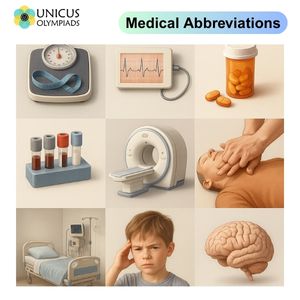What Are Medical Abbreviations Like BMI, ECG, and Rx Used For in Healthcare?
In healthcare, medical abbreviations are used to simplify communication, making it easier and faster for medical professionals to document and discuss patient care. Abbreviations like BMI, ECG, and Rx are commonly used to refer to important concepts, tests, or treatments. These abbreviations are essential for medical documentation and are used across various healthcare settings, including hospitals, clinics, and pharmacies. Below is an explanation of what these terms mean, how they are used, and why they are important in healthcare.
BMI (Body Mass Index)
Full Form
BMI: Body Mass Index
Explanation
- BMI is a measurement that helps assess whether a person has a healthy body weight for a given height. It is widely used by healthcare professionals as a screening tool to identify whether someone is underweight, normal weight, overweight, or obese.
- BMI is calculated using the following formula: BMI = weight (kg) / height (m)².
Use in Healthcare
- Assessment of Obesity: BMI is a quick way to assess whether an individual is at risk of obesity-related conditions, such as heart disease, diabetes, and hypertension.
- Screening Tool: While BMI does not directly measure body fat percentage, it serves as a simple tool for screening and identifying potential health risks related to weight.

ECG (Electrocardiogram)
Full Form
ECG: Electrocardiogram
Explanation
- ECG is a test used to measure the electrical activity of the heart. It provides a graphical representation of the heart's rhythm and electrical impulses, which can help diagnose heart conditions, arrhythmias, and other cardiovascular issues.
- An ECG records the timing and strength of electrical signals that make the heart beat. Healthcare providers often use it to detect problems like irregular heart rhythms, heart attacks, and other cardiac conditions.
Use in Healthcare
- Diagnosing Heart Conditions: ECGs are used to diagnose a variety of heart conditions, such as arrhythmias, heart attacks, and congenital heart defects.
- Monitoring Heart Health: ECGs are also used to monitor the heart's electrical activity in patients with heart disease or those undergoing heart surgery.
- Non-invasive Procedure: The test is non-invasive, making it a routine procedure for heart health monitoring in clinics and hospitals.
Rx (Prescription)
Full Form
Rx: Prescription
Explanation
- Rx is a commonly used abbreviation in healthcare that refers to a prescription, specifically a medication order from a healthcare provider to a pharmacist. It indicates that a patient requires a specific medication, dosage, and instructions for its use.
- The term "Rx" comes from the Latin word "recipe," meaning "take," as an imperative command to "take this medication." It is often written at the beginning of a prescription to indicate the start of the medication order.
Use in Healthcare
- Medication Orders: Rx is used by doctors and healthcare providers to prescribe medications to patients. It includes details such as the name of the medication, dosage, frequency, and duration of use.
- Pharmacy Instructions: Pharmacists use the Rx notation to accurately fill medication orders according to the doctor's prescription, ensuring that the right drug is dispensed to the patient.
Other Common Medical Abbreviations
1. CBC (Complete Blood Count)
CBC: Complete Blood Count
A CBC is a blood test used to assess overall health and detect a variety of disorders, including anemia, infection, and many other diseases. It measures the levels of red blood cells, white blood cells, platelets, hemoglobin, and hematocrit in the blood.
2. MRI (Magnetic Resonance Imaging)
MRI: Magnetic Resonance Imaging
An MRI is a diagnostic test that uses powerful magnets and radio waves to create detailed images of the inside of the body, particularly soft tissues like the brain, muscles, and organs. It is used to diagnose a variety of conditions, including neurological disorders, joint injuries, and cancers.
3. CPR (Cardiopulmonary Resuscitation)
CPR: Cardiopulmonary Resuscitation
CPR is an emergency life-saving procedure performed when the heart stops beating. It involves chest compressions and, in some cases, artificial ventilation to restore blood flow and oxygen to the brain and other vital organs until medical help arrives.
4. ICU (Intensive Care Unit)
ICU: Intensive Care Unit
The ICU is a specialized hospital unit designed for patients with severe or life-threatening conditions, such as heart attacks, strokes, or surgeries. It is equipped with advanced monitoring and life-support equipment to manage critical health conditions.
5. ADHD (Attention Deficit Hyperactivity Disorder)
ADHD: Attention Deficit Hyperactivity Disorder
ADHD is a neurodevelopmental disorder characterized by persistent symptoms of inattention, hyperactivity, and impulsivity. It is commonly diagnosed in children but can continue into adulthood. Treatment often involves behavioral therapy and medication.
Why Are Medical Abbreviations Important?
1. Efficient Communication
Medical abbreviations are crucial for efficient communication among healthcare professionals. With busy schedules and the need for quick decision-making, abbreviations help doctors, nurses, and other staff communicate effectively and save time.
2. Reducing Errors
When used correctly, medical abbreviations help standardize communication and reduce the chances of misinterpretation. For example, an abbreviation like "Rx" for prescription eliminates confusion and ensures that everyone understands that a medication order is being made.
3. Record Keeping
Medical records are filled with abbreviations, which allow for compact, easy-to-read documentation of patient care. This is essential for maintaining comprehensive patient histories that can be quickly reviewed when needed.
4. Standardization
Using standardized medical abbreviations across healthcare settings ensures that all professionals understand the same terminology, promoting clarity and consistency in patient care and medical procedures.



